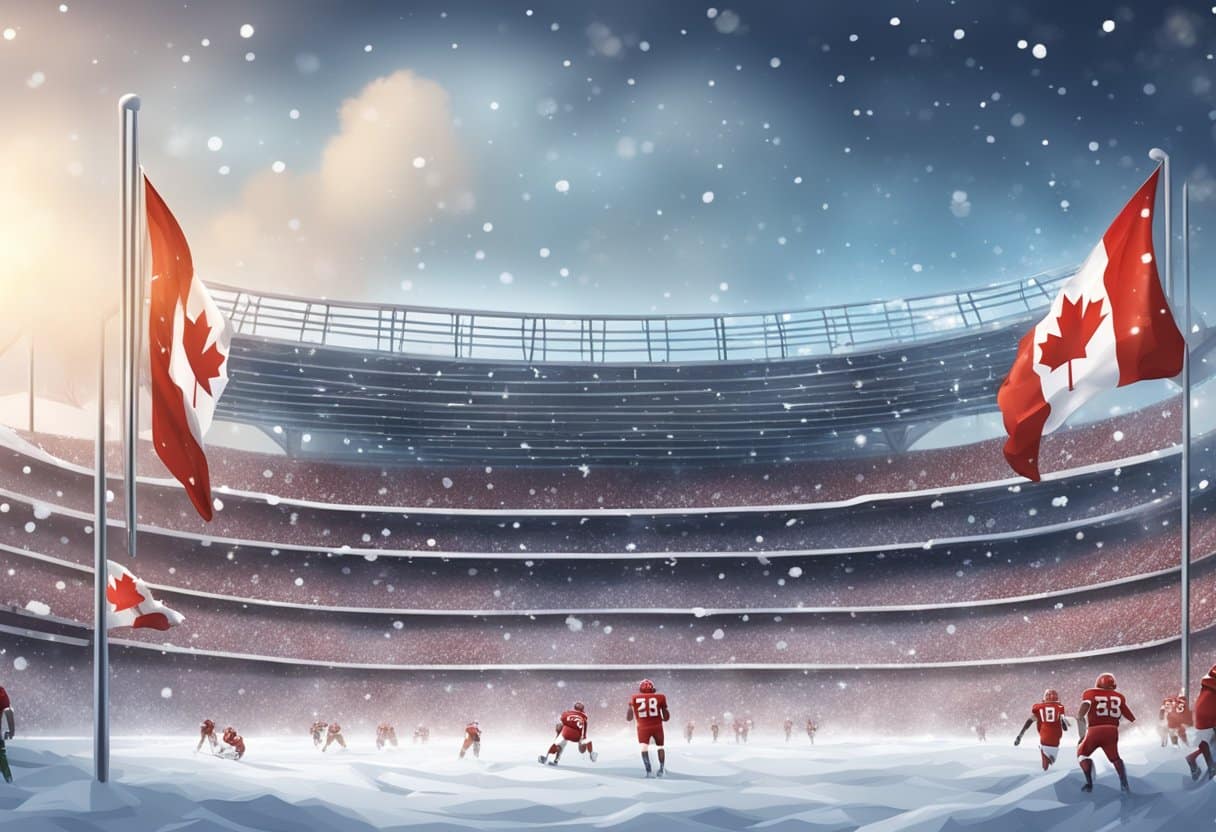Weather plays a crucial role in Canadian Football League (CFL) games, often creating unique betting opportunities for those who understand its impact. The prairie stadiums in cities like Calgary and Edmonton regularly experience high winds that can significantly alter game outcomes and point totals. Weather conditions can influence both player performance and team strategies, making it an essential factor for bettors to consider before placing their wagers.

In recent years, severe weather incidents affecting CFL games have increased noticeably. This trend has prompted the league to develop more comprehensive weather protocols while simultaneously creating new angles for sharp bettors. Understanding how rain, wind, extreme temperatures and other weather elements affect different teams and stadiums across Canada can provide a valuable edge in the betting market.
The CFL’s northern location means weather patterns differ significantly from other football leagues, with some stadiums experiencing uniquely challenging conditions. Cold snaps, sudden storms, and prairie winds create situations where the prepared bettor can find value that others might miss. Taking time to analyze weather forecasts before placing bets on CFL games can be the difference between winning and losing in the long run.
Understanding the Basics of CFL Betting

The Canadian Football League (CFL) offers unique betting opportunities with its distinct rules and gameplay. Before placing wagers on CFL games, it’s essential to understand both the league structure and the various betting options available.
Explaining the CFL: Teams and Structure
The CFL consists of nine teams divided into East and West Divisions. The East Division includes the Montreal Alouettes, Ottawa Redblacks, Toronto Argonauts, and Hamilton Tiger-Cats. The West Division features the BC Lions, Calgary Stampeders, Edmonton Elks, Saskatchewan Roughriders, and Winnipeg Blue Bombers.
Unlike American football, the CFL plays with 12 players per side on a larger field. Teams have only three downs to advance 10 yards instead of four, which creates more passing plays and higher-scoring games.
The CFL season typically runs from June to November, culminating in the Grey Cup championship. This 18-game regular season schedule provides numerous betting opportunities throughout the summer and fall months.
Betting Odds and Types in CFL
CFL betting offers several wagering options similar to other football leagues. The most common bet types include:
Moneyline: Simply betting on which team will win the game outright.
Point Spread: Betting on whether a team will win by more than a specified margin or lose by less than that margin.
Totals (Over/Under): Wagering on whether the combined score of both teams will be over or under a number set by oddsmakers.
The CFL’s three-down format and wider field often lead to higher-scoring games, which can affect how totals are set. Some sportsbooks also offer prop bets on player performances and game events, though these may be more limited than in more popular leagues.
Weather conditions play a significant role in CFL betting, especially in outdoor stadiums where wind, rain, or snow can dramatically impact gameplay and scoring.
Importance of Weather in CFL Games

Weather conditions play a crucial role in Canadian Football League games, affecting everything from player performance to coaching strategy. The CFL’s Weather Protocol helps teams prepare for various conditions, but understanding these weather impacts gives bettors a potential edge.
Temperature and Player Performance
Cold weather significantly impacts player performance in CFL games. When temperatures drop below freezing, which often happens in late-season games, players experience reduced grip strength and decreased muscle flexibility. This affects quarterbacks and receivers most directly, leading to fewer completed passes and more conservative play-calling.
Players from warmer regions may struggle more with adaptation to extreme cold. Canadian players sometimes have a slight psychological edge in frigid conditions, having grown up playing in such weather.
Teams often adjust their game plans based on temperature forecasts. Extremely cold games typically favour teams with strong running games and solid defensive lines.
Heat can also be a factor in early-season games, causing fatigue and cramping. Teams with better conditioning programs often perform better in unusually hot conditions.
Impact of Wind on the Game
Wind is perhaps the most underrated weather factor in CFL betting. Strong winds significantly affect passing accuracy and kicking distance. In stadiums like Mosaic Field in Regina or McMahon Stadium in Calgary, wind gusts can reach 40+ km/h.
The CFL’s wider field makes passing games more vulnerable to wind disruption than in other football leagues. Quarterbacks must adjust throwing mechanics, often resulting in more interceptions and incomplete passes.
Smart coaches plan their game strategy around wind direction:
- With the wind: Teams often attempt longer passes and field goals
- Against the wind: Teams rely more on running plays and short passes
Punting strategy changes dramatically with wind conditions. Teams may opt for shorter, higher punts against the wind to prevent long returns.
Precipitation’s Effect on Strategy
Snow and rain create some of the most challenging conditions in CFL games. Wet balls lead to fumbles, dropped passes, and unpredictable outcomes. Statistics show fumble rates increase by nearly 25% during games with significant precipitation.
Snow affects player footing and visibility. Teams with power running games often gain an advantage in snowy conditions, while pass-heavy offences may struggle.
Field conditions deteriorate rapidly during precipitation. CFL stadiums have various drainage systems and field types that respond differently to rain and snow:
- Artificial turf becomes slippery but maintains consistency
- Natural grass becomes muddy and unpredictable
The CFL Weather Protocol allows games to be declared final after the halfway point (7:30 mark) if severe weather poses safety concerns. This rule adds another strategic element for coaches managing game pace during threatening weather.
Historical Weather Patterns in Canadian Stadiums

Weather has played a significant role in CFL games throughout the league’s history. Canadian stadiums experience diverse and often extreme weather conditions that directly impact game play and betting outcomes.
Stadiums with Notorious Weather Conditions
Tim Hortons Field in Hamilton is well-known for its challenging weather patterns. The stadium’s location near Lake Ontario creates unpredictable wind conditions that have affected passing games and kicking strategies.
McMahon Stadium in Calgary experiences some of the most variable weather in North America. Games have been played in temperatures ranging from -30°C in late-season contests to +35°C during summer months. The stadium’s elevation also contributes to thinner air, which historically has benefited kickers.
Mosaic Stadium in Regina is famous for its brutal winter conditions. The open-air facility offers little protection from Saskatchewan’s prairie winds, which have reached speeds of over 60 km/h during playoff games.
Analyzing Past Weather-Related Game Outcomes
Statistical analysis shows that CFL teams playing in adverse weather conditions tend to rely more heavily on running plays. Since 2019, when the CFL Weather Protocol was established, games with heavy precipitation have averaged 23% fewer passing yards.
Weather delays due to lightning have affected game momentum significantly. Records indicate that teams leading before weather delays maintain their advantage approximately 65% of the time when play resumes.
Cold-weather games (below -10°C) historically produce lower scoring outcomes. The five-year average for total points in these conditions is 41.3, compared to 54.7 points in moderate weather.
Wind impact varies by stadium design. In Hamilton’s Tim Hortons Field, field goal success rates drop by nearly 18% when wind speeds exceed 25 km/h, creating interesting opportunities for bettors who monitor weather forecasts.
Calculating the Weather Advantage
Weather can dramatically shift the odds in CFL betting when properly analyzed. Smart bettors who accurately assess weather impacts gain a significant edge over both bookmakers and casual players who overlook these critical factors.
Pre-Game Weather Research for Bettors
Weather forecasts should be checked within 24 hours of kickoff for maximum accuracy. The most reliable sources include Environment Canada and local meteorological services that provide hourly predictions for game time conditions.
Wind direction and speed deserve special attention, particularly in open-air stadiums like McMahon Stadium in Calgary or Mosaic Stadium in Regina. Winds exceeding 20 km/h can reduce passing effectiveness by 15-20% and dramatically affect field goal success rates.
Temperature extremes also merit consideration. Early and late-season games often feature temperatures below 5°C, which typically reduces scoring by 3-5 points compared to seasonal averages.
Key Weather Metrics to Track:
- Wind speed and direction
- Precipitation amount and timing
- Temperature at kickoff
- Field condition reports
Adapting Betting Strategies to Weather Forecasts
When heavy rain is predicted, experienced bettors typically adjust toward “under” bets on point totals. CFL games played in steady rain show a historical 18% decrease in total points scored compared to clear conditions.
Wind impacts vary by team. Squads with run-heavy offences like the Hamilton Tiger-Cats often maintain performance in windy conditions, while pass-dependent teams see efficiency drop by up to 25% in strong crosswinds.
The “weather line movement” offers another advantage. When severe weather is forecast, waiting until just before kickoff can provide better odds as casual bettors and bookmakers may overreact to weather reports.
Teams that regularly practice in adverse conditions often forge resilience to weather impacts. The Winnipeg Blue Bombers, for example, historically outperform the spread in cold weather games by 3.5 points on average.
Case Studies: Weather’s Role in Iconic CFL Matches
Weather has dramatically shaped some of the most memorable games in CFL history, forcing teams to adapt their strategies and players to overcome challenging conditions. These notable weather-affected matches have become part of league lore.
The Snow Bowl: Reliving the Grey Cup Classic
The 2017 Grey Cup between the Toronto Argonauts and Calgary Stampeders stands as perhaps the most famous weather-affected match in recent CFL history. Played in Ottawa, the game featured snowfall so heavy that stadium crews struggled to clear yard lines.
The Argonauts, underdogs in the contest, used the equalizing effect of the snow to their advantage. Toronto’s defensive backs found traction issues working in their favour as Calgary’s receivers struggled with footing and visibility.
Late in the game, Argonauts receiver DeVier Posey scored a crucial 100-yard touchdown despite the treacherous conditions. Toronto ultimately won 27-24, with the snow becoming the unexpected star of the show.
Hamilton Tiger-Cats’ Weather Resilience
The Tiger-Cats have built a reputation for weather adaptability at Tim Hortons Field, where Lake Ontario’s proximity creates unique weather patterns.
During a particularly blustery October 2018 game against Ottawa, Hamilton shifted to a ground-heavy attack when 60 km/h winds made passing nearly impossible. Running back Alex Green powered through for 140 yards despite the challenging conditions.
In 2019, the Tiger-Cats faced Montreal during a game with temperature drops of nearly 15 degrees. Hamilton’s coaching staff had prepared multiple equipment options, allowing players to adjust between quarters as conditions changed.
This weather versatility contributed to Hamilton’s strong home-field advantage in recent seasons.
Toronto Argonauts’ Strategies in Inclement Weather
The Argonauts have developed specific weather-related strategies at BMO Field, where wind off Lake Ontario can significantly impact gameplay.
During a 2021 rainstorm against Saskatchewan, Toronto implemented their “wet-ball drill” preparation. Quarterbacks and receivers had practiced extensively with soaked footballs, resulting in fewer drops than their opponents.
The Argonauts’ special teams unit has also mastered wind assessment. Kicker Boris Bede studies pre-game wind patterns to adjust his technique accordingly.
In 2022, when a thunderstorm interrupted their game against Montreal, Toronto’s coaching staff used the delay strategically. They adjusted their defensive scheme during the unplanned break, ultimately securing a comeback victory once play resumed.
Leveraging Weather Factors for Live Betting
Weather conditions can change rapidly during CFL games, creating unique opportunities for bettors who pay close attention. Monitoring these shifts in real-time allows for strategic wagering that many casual bettors might miss.
In-Game Adjustments to Weather Shifts
Live betting requires quick thinking when weather conditions change during a game. Wind that suddenly picks up can dramatically affect passing and kicking strategies, especially in open-air stadiums like McMahon Stadium in Calgary.
Temperature drops during evening games can cause the ball to lose air pressure, potentially shortening passing distances. Smart bettors watch for quarterbacks adjusting their throwing power accordingly.
Rain that begins mid-game typically favours defensive teams and the Underdog, as the likelihood of fumbles increases. When precipitation starts, consider betting the under on total points or backing the defensive team getting points.
SIA (Sports Information Analytics) data shows that teams trailing when unexpected weather hits often struggle to execute comeback passing strategies, making the leading team a solid live bet.
Recognizing Live Betting Opportunities
The ideal time to place weather-related live bets is immediately after conditions change but before oddsmakers fully adjust their lines. This window typically lasts only 5-10 minutes.
Key Weather Signals for Live Betting:
- Sudden wind gusts affecting kick direction
- Rain starting or intensifying
- Temperature dropping significantly after sunset
- Snow beginning to accumulate on the field
Monitoring social media accounts of stadium reporters provides real-time weather updates that broadcast cameras might not capture. These insights can reveal field condition changes before they affect play.
Teams with versatile offensive schemes like the Winnipeg Blue Bombers can adjust to weather changes more effectively than one-dimensional offences. This adaptability makes them less vulnerable as Underdogs when conditions deteriorate.
Advantageous Practices for the Weather-Savvy Bettor
Smart CFL bettors develop specific strategies to leverage weather information effectively. They build reliable information networks and create systematic approaches to integrate weather factors into their betting decisions.
Building a Reliable Weather Information Network
Successful weather-conscious bettors rely on multiple forecasting sources rather than a single weather app. They follow local meteorologists from CFL cities who understand regional weather patterns and their effects on specific stadiums.
Social media provides valuable real-time updates. Following team reporters who post pre-game field conditions and players’ reactions to weather can offer crucial insights unavailable through standard forecasts.
Stadium-specific knowledge matters tremendously. Each CFL venue has unique characteristics that interact differently with weather conditions. Some fields drain better after rain, while others become particularly slippery.
Creating a personal database of how specific teams have historically performed in various weather conditions at each stadium provides a competitive edge over casual bettors.
Integrating Weather Insights into Betting Models
Savvy bettors assign numerical values to different weather factors in their handicapping models. For instance, winds above 30 km/h might adjust a point total prediction downward by 3-5 points.
They monitor line movements when weather forecasts change. If a snowstorm is predicted for a game where the total opened at 50.5, smart bettors watch how the line moves and identify value opportunities.
Weather factors should be weighted differently based on team characteristics. Teams with run-heavy offences typically fare better in poor weather than pass-dependent squads.
Bankroll management becomes especially important for weather-influenced bets. Experienced bettors may increase their stake when they identify weather advantages that the broader market hasn’t fully accounted for.
Conclusion: Mastering the Elements for CFL Betting Success
Weather plays a crucial role in CFL betting success. Smart bettors who track and analyze weather conditions gain a significant edge in their wagering decisions.
Wind impacts passing games and field goal attempts, while rain and snow can reduce scoring and favour teams with strong running attacks. Temperature extremes affect player performance and should be factored into betting strategies.
Key weather factors to monitor:
- Wind speed and direction
- Precipitation type and intensity
- Temperature and humidity
- Field conditions resulting from weather
Stadium design matters too. Some CFL venues offer more protection from elements than others, creating unique betting opportunities based on weather forecasts.
Successful CFL bettors combine weather analysis with other important statistics. This includes team performance metrics, injury reports, and historical performance under similar conditions.
Creating a personal weather-related betting system helps track patterns over time. Document games played in various conditions and note how different teams perform when facing weather challenges.
Remember that sportsbooks already factor some weather information into their lines. The advantage comes from deeper analysis and finding situations where weather impact might be undervalued or overvalued.
Weather alone isn’t everything, but it provides an extra layer of insight. When used alongside other betting strategies, weather analysis can be the difference between breaking even and turning a profit in CFL betting.





